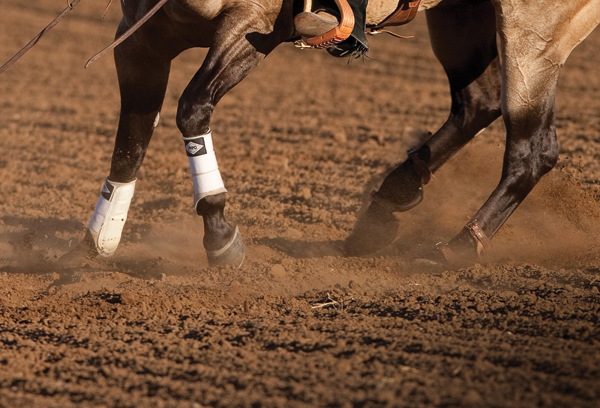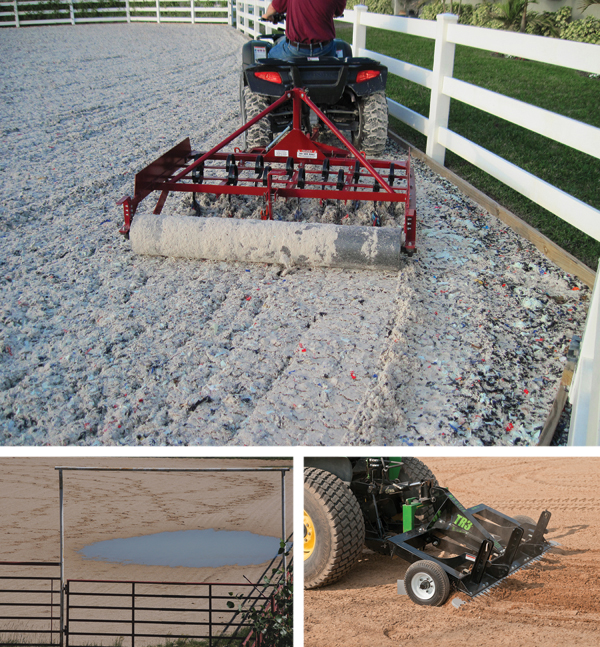Take a hard look at the arena where you ride. Are you—and equally importantly, your horse—often engulfed in a dust storm? Or does water accumulate in places that you avoid like quicksand? Are some areas so hard and slick that your horse feels like he skates over them? Do your arena edges bank so much that they often resemble a NASCAR track? We can relate, because we’ve faced similar problems with our own arenas, and even at public ones we haul to on occasion. Creating and maintaining a good arena surface is obviously important.

For help, we corralled Jim and Bob Kiser, owners of Kiser Arena Specialists. If you’ve ever been to the World Championship Quarter Horse Show, the National Reining Horse Association Futurity, or were lucky enough to attend the 2010 World Equestrian Games, you’ve seen the fruits of their labors—arenas that are perfectly level and dust-free, with combed, fluffy top layers that provide cushion and traction for the horses.
We asked for their advice on how to get the most from arena ground; here are some tips they shared.
Initial Diagnosis
How do you know if your arena needs work? Jim favors a simple test to determine whether your arena surface is just right or not.
“My test is pretty simple—it has to feel good to walk on. If an arena surface doesn’t feel good for you to walk on, it isn’t going to be comfortable for the horse, either.”
But getting to “feels good” isn’t so simple. The conditions you can expect from any riding arena’s ground, even with the costliest maintenance equipment, are tied directly to its construction. For optimal results, you can’t just put a fence around a span of bare dirt and call it good. Instead, your arena needs a hard, durable base layer that’s about half a foot deep, with a top layer of 2.5 inches to 3 inches, depending on your preferences and the event you’re interested in doing.
If you’ve been attempting to train on make-do ground, or if your arena is long-neglected, you may need to bring in a professional to get your surface to this degree of condition. The essential idea is that the base needs to be level if indoors, or slightly tilted to allow for runoff if outdoors. The slope of a well-engineered outdoor arena will vary from one-half to one-percent grade (a measure of the rise divided by the run, multiplied by 100). If water-pooling is a problem with your current arena, that’s evidence of faulty grading.
To determine slope for an outdoor arena, professionals like the Kisers consider the footing materials used and the local weather. If you contend with heavy, rapid rain showers, for instance, less slope is desirable, so that materials don’t wash away. If your arena has good drainage and milder, drizzly rains characterize your area, more slope might be advised.
Whatever the case, the base layer needs to be graded and compacted. To do this, the contractor is likely to scrape off the top materials so that he can regrade and compact the base underneath. Once this is done, the top layer is brought back in or replaced with new materials to create a loose top layer.
Once the work is completed, your goal becomes to keep the top layer loose and evenly distributed over the entire arena surface. And here’s the big take-home message: The more deliberate and frequent you are in conditioning the top layer, the longer your base layer will stay in good shape.
Tip-Top Regularity
We say “tip-top” because, if done properly, it’s the top layer of your arena surface that you must mainly be concerned with from week to week, even year to year. Ideally, say the Kisers, your top layer should always be worked up enough so that a horse in training isn’t going to penetrate that layer and damage the base.
Both men agree, the most common problem they see is that people don’t drag their arenas often enough. According to Bob, if you’re among those who work their arenas every few weeks or so, or even once a week, you aren’t doing it nearly enough.
In fact, he recommends that an arena be worked every day, before anyone rides on it, as a matter of course. He says this level of regularity is just as important for the amateur who rides one or two horses a day as it is for a boarding or training establishment where many horses use the surface daily.
Why? The main reason is moisture. Ideally, an arena should have a moisture level of four to six percent. If you work the arena once a week, or once a month, and are irregular about watering it as well, it’ll dry out. That’ll give you that dreaded riding-in-a-cloud-of-dust problem—not to mention what’ll happen the next time you drive over the surface with machinery, in the attempt to smooth it out.
Chances are, you can’t measure the moisture level of your arena. So, here’s an easy way to judge moisture factor. Pick up a handful of the top material. If it won’t bind together, it’s probably too dry; if dust billows out of your hand, it’s definitely too dry. And if it forms a muddy ball in your hand, it’s too wet. Ideally, the materials should ball up in your hand but still be dry enough to crumble.
If you lack a pull-behind watering system and have to settle for watering your arena with a garden hose, you may be pleased to learn that several arena-watering systems designed for home-arena use are available. Portable models typically follow a hose line down the center of the arena, providing even watering of the entire surface. Another possibility is a dedicated watering system, similar to a lawn-sprinkling system, that can be installed along the arena fences. Just be sure the patterns are worked out so that watered areas don’t overlap too heavily or that areas are left unwatered.
Equipment
While it’s safe to say that we each have our own limit on what we can afford to spend for arena-conditioning equipment, it’s also safe to say that what’s available for equipment is much improved over what was common 20, even 10 years ago.

Formerly, horsemen simply used a simple harrow rake or a section of chain fence attached to a tractor. If this is what you’re using today, you know the problem: These pieces of equipment can help smooth out a surface, but they can’t replace footing that’s been pushed and banked to the outer edges by horses’ hooves, nor can they soften the increasingly compounded ground left behind in the horses’ regular working track.
To envision this, imagine a cake. The cake layer represents your arena’s base, and the icing is the top layer of your footing. If you use a knife and go around and around in a circle, you’ll push the icing to the edges. If too much icing is moved, your knife can dig into the cake—destroying the level base.
So, what you need to do is move that icing back to the areas that are heavily used, creating a finish of uniform thickness.
Today’s most elaborate arena conditioners are actually several tools integrated into a single unit. These tools redistribute the top layer more evenly, rake it to give it the proper texture, and at the same time compact the base layer and repair damage. Bob built a pro-quality arena conditioner called the Kiser Dragmaster to work the ground at the 1987 NRHA Futurity, and it’s become the gold standard in the business. A lower-priced version, the Kiser Edge, is used at many smaller facilities.
Additionally, implement makers have created a wide variety of all-in-one arena tools to make arena maintenance simpler. Some fit on tractors, while a handful of the implements even work on four-wheel ATVs or motorized utility vehicles. One of the more popular is the TR3 rake, distributed by ABI Equine. John Deere offers a quality product, the Riata Rake, through its Frontier line of tractor implements. Smaller companies, such as Roto Harrow, specialize in making arena equipment for home-based riders.
The purchase of equipment to upkeep your riding surface may seem like a big expense. But when you weigh that cost against the vet bills and downtime from a surface-caused lameness, not to mention risks to your own health from a bad fall as you’re in the saddle, you may start to see it as an investment.
General Tips
Besides regular dragging and applying moisture to keep the top layer in proper balance, you can help keep your arena in top shape with these three final tips from the Kisers.
Vary your riding routine. Repetitive practice, especially running barrel patterns or endless circling alongside the arena walls, causes your top materials to migrate, forming thin spots and areas of buildup. Prevent this by reversing the set-up of your barrels, by working down the center of the arena and diagonally instead of always on the rail, by moving your trail obstacles to new locations, and so forth—anything to break out of the pattern.
Keep your riding in mind when conditioning. If you have thin spots from repetitive riding patterns, you’ll want to drag those areas more thoroughly than the less-used areas and establish a dragging pattern that helps redistribute the top materials more evenly.
Prioritize good ground. “If there’s one thing I’d tell people,” says Bob, “it’s that you have to do what it takes to keep the top layer consistent. If it means hiring someone to pull the dirt away from the fence, then do it. And do the arena-conditioning work each day, before you ride.”






